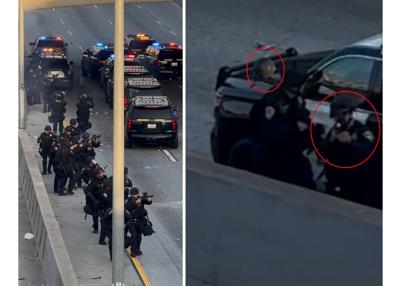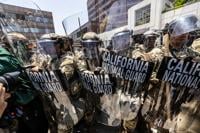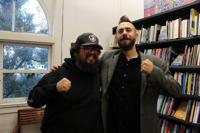
(Photos from the case taken by Erron Bounds, courtesy of Hadsell Stormer Renick & Dai LLP)
In early June, Ben Camacho found himself in one of the dozens of protests that had erupted across Southern California in response to the immigration raids brought on by the Trump administration. The difference between him and most people there is that he is a journalist who has been targeted by law enforcement in Los Angeles for years. Now, instead of being sued by the city, he is taking the county to court.
Journalist Camacho and community members Jack Kearns and Erron Bounds joined their lawyers at Hadsell Stormer Renick & Dai, LLP in filing tort claims to initiate lawsuits against the Los Angeles Police Department and Los Angeles Sheriff’s Department for unlawfully shooting them with 40mm “less lethal” rubber bullets.
The lawyers argue that the LAPD, CHP and LACSD have “used these potentially deadly weapons to unlawfully attack journalists and demonstrators” throughout the last few weeks of protests where Angelenos have been protesting the president's raids targeting Latino communities.
Law enforcement is aiming harmful rubber bullets directly at individuals in crowds
What has become common are the images and headlines about how Los Angeles law enforcement uses rubber bullets and tear gas. Throughout the 2020 protests, reports of rubber bullets and tear gas in Los Angeles skyrocketed, with law enforcement being found liable for spraying tear gas indiscriminately.
Now, the reaction by Los Angeles law enforcement has been for rubber bullets to be shot more directly to avoid being held accountable for indiscriminate shots, according to Rebbeca Brown, the lead attorney for the case.
On June 8, Erron Bounds was peacefully protesting ICE on a bridge over the 101 freeway when, allegedly, a CHP officer on the freeway below aimed directly at them and shot them in the face with a rubber bullet.
They were able to catch the bullet on camera the very moment the shot was fired and capture the bullet in the frame:
Shot two times, directly
It's June 7, at around 5 p.m. and with a helicopter hovering above, Camacho Camacho saw what he regularly sees: there are several different kinds of folks.
It's Compton, where over two-thirds of the population is Latino.
Families here trace their roots to Oaxaca, Guatemala, El Salvador, and Michoacán—places whose songs, languages and prayers echo in Compton’s markets, schoolyards and backyards.
When ICE descends on the city, it's not an abstract policy debate—it’s neighbors, classmates, and coworkers who are at risk. That brings out the folks who are new to protests and those who organize them.
“There was a street takeover going on...people doing donuts, there's that car that was burning,...people waving flags, in my opinion, nothing out of the ordinary for L.A.,” said Camacho. “But there was this very large police presence that had kind of established a perimeter over by the freeway bridge. And that was mainly held by the L.A. sheriffs.”
After the sun goes down, “maybe it's like eight o'clock or so. And I kind of also felt like there was like an increase in like the flashbangs and like rubber bullets that were getting shot around that time,” he remembers.
Then Camacho sees a fellow photojournalist fall after being hit by the rubber bullet.
A flash—something blunt and fast—struck the photojournalist Nick Stern folding them at the waist. Camacho watched as the man clutched his side, limping toward the curb. Instinctively, Camacho moved in, his arm wrapping around his frame, helping guide him away from the clash unfolding between citizens and the state.
Others stepped in to help, and for a brief moment, Camacho felt it was safe to return to his work. He turned back toward the protest line, camera slung across his chest, a press badge visible and bouncing gently against his sternum.
He lifted his phone—midway through posting a field update that his outlet was resharing—when it happened.
A sudden eruption of heat and force, as if a cannonball had torn through the air and lodged itself into his knee. It was pain that burned and stabbed at once, an unforgiving collision of bone and rubber and velocity. Camacho screamed. The world narrowed.
As he sought cover, he was shot again, this time in his arm.
State law is clear, but it's being ignored
What happened to Camacho Camacho on that June day—shot once while helping an injured photojournalist and again while wearing a press badge clearly around his neck—is not an isolated event.
As civil rights attorney Rebecca Brown tells me, he is one of potentially hundreds in Los Angeles who have been targeted with rubber bullets by law enforcement in recent weeks: shot in the face, the groin, the back of the head. Protesters like Jack Kearns and Erron Bounds now bear the physical and emotional scars of a system that sees public dissent not as a right, but as a threat.
“These are extremely calm protests,” Brown said. “And law enforcement is saying to these people, ‘You need to be afraid to come out. You need to submit to fascism.’”
California law explicitly prohibits what’s happened— the use of kinetic impact weapons against peaceful protestors or journalists, aimed at vulnerable parts of the body. And yet, Rebecca Brown has seen the pattern before. From 2020 to now, the message from LAPD, LASD, and CHP has not changed: Do not show up. Do not bear witness. Do not resist.
But the lawsuits filed this week push back on that message.
They aren’t just about Camacho, Bounds, and Kearns—they’re a stand for everyone who chooses to document, demonstrate or simply exist in the public square without fear. They assert that the right to gather, to speak, to report, is not a privilege granted by police discretion—it is a constitutional guarantee.
As Brown said, “The courts know. The legislature knows. The departments know. These weapons can kill. And they’re being used anyway. It’s barbaric.”











(0) comments
Welcome to the discussion.
Log In
Keep it Clean. Please avoid obscene, vulgar, lewd, racist or sexually-oriented language.
PLEASE TURN OFF YOUR CAPS LOCK.
Don't Threaten. Threats of harming another person will not be tolerated.
Be Truthful. Don't knowingly lie about anyone or anything.
Be Nice. No racism, sexism or any sort of -ism that is degrading to another person.
Be Proactive. Use the 'Report' link on each comment to let us know of abusive posts.
Share with Us. We'd love to hear eyewitness accounts, the history behind an article.